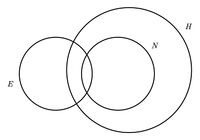8. Complete measures
(待修改! ) Definition
is a -algebra and is a measure, we say that the pair is complete if
-
Remark It is clear that since .
Remark We can replace by any classes and define the same concept.
is a -algebra and is a measure, our goal is find a -algebra and a measure such that
-
Moreover, we will show that the completion is unique.
Let and is a measure, we construct Claim is a -algebra.
-
It is clear since we can always write .
-
Assume that , then where and such that .
Since and , we conclude that .
-
Suppose that , then where and such that for all . Since and and , .
The construction of tells us that .
Next, we define an extension of .
Observation .
So, we define Then we claim that
- is well-defined
Let , , and . Since and are symmetry, it sufficient to show that . , so .
- is an extension of indeed.
, we can always write , . Therefore, is indeed an extension of .
- is a measure
Let and , we can write , and such that for all . Note that are disjoint two by two, are disjoint two by two since .
, and . By definition
- is complete. (sometimes we call is -complete)
Suppose that and . Since , , and such that .
, and .
, so and then .
Observation The construction of is depend on . So we will write as when we need to emphasize this dependency.
- The extension of is unique.
If we have another measure such that for . Select , then , and such that . Since and are agree at , . and So and are agree at and it is what we want to prove.
Given an outer where is a measurable set.
Claim
is -complete.
Given and , we need to prove that , it equals to for .
- , then -
So .
